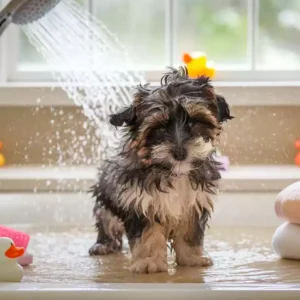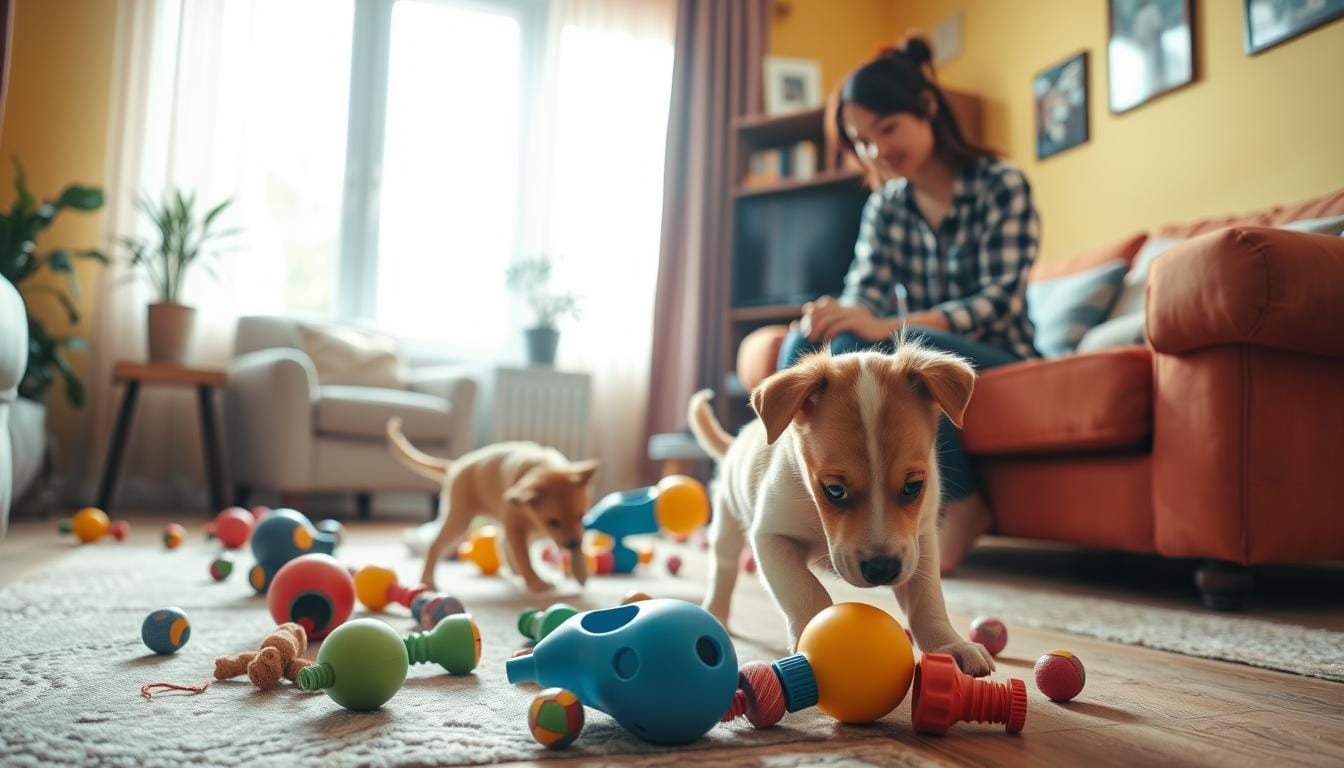
Training a new puppy is exciting, but simple mistakes can slow progress and cause bad habits. Many pet owners struggle when they train new puppy due to inconsistent routines, lack of patience, or using outdated methods. In this guide, we’ll cover the biggest mistakes to avoid when you train new puppy, so you can build a strong bond and raise a well-behaved companion.
Starting your puppy’s training early is key to avoiding common mistakes. This helps prevent bad behaviors from forming1. You want your puppy to grow into a well-behaved and loyal friend. Avoiding these errors is vital for this goal.
One major mistake is not beginning training early enough. Young puppies can learn basic commands and rules from the start. This helps you steer clear of common training errors.
Knowing these common mistakes helps you prevent bad behaviors. It sets a strong foundation for your puppy’s growth. This leads to a stronger bond between you and your puppy, reducing training errors.
Remember, starting early, being consistent, and avoiding common mistakes are crucial. Learning about these mistakes is essential for successful puppy training.
Key Takeaways
- Avoid common mistakes to avoid when training a new puppy, such as not starting training early enough1.
- Be consistent in your training approach to prevent bad behaviors from developing.
- Start puppy training early, even if it’s just basic commands and boundaries.
- Avoid rewarding demand behaviors, as they can become established habits1.
- Use tools like crates, playpens, and gates to ease puppy training and reduce unwanted behaviors1.
- Engage your puppy in supervised playdates to reduce aggressive behaviors later in life1.
Understanding Your Puppy’s Development Stages
Training your puppy is easier when you know their growth stages. Puppies learn a lot when they’re awake, so they can start learning right away2. This is a great time to introduce them to new people, places, and things. It helps them learn to get along well with others and avoid common mistakes in training.
The time from 12 to 15 weeks is very important for social learning3. Puppies are most open to new things during this period. It’s important to expose them to various environments, people, and experiences. This helps them develop good social skills and prevents common training errors.
Here are some key points to consider during your puppy’s development stages:
- Puppies between the ages of 6 to 16 weeks are very open to learning, making this a key time for training and socialization3.
- Positive reinforcement is key to successful training, with studies showing it leads to a 75-80% better learning outcome compared to punishment2.
- Consistently rewarding puppies during socialization and adaptation with positive reinforcement can influence the likelihood of good behavior later in life3.
The Importance of Timing in Puppy Training
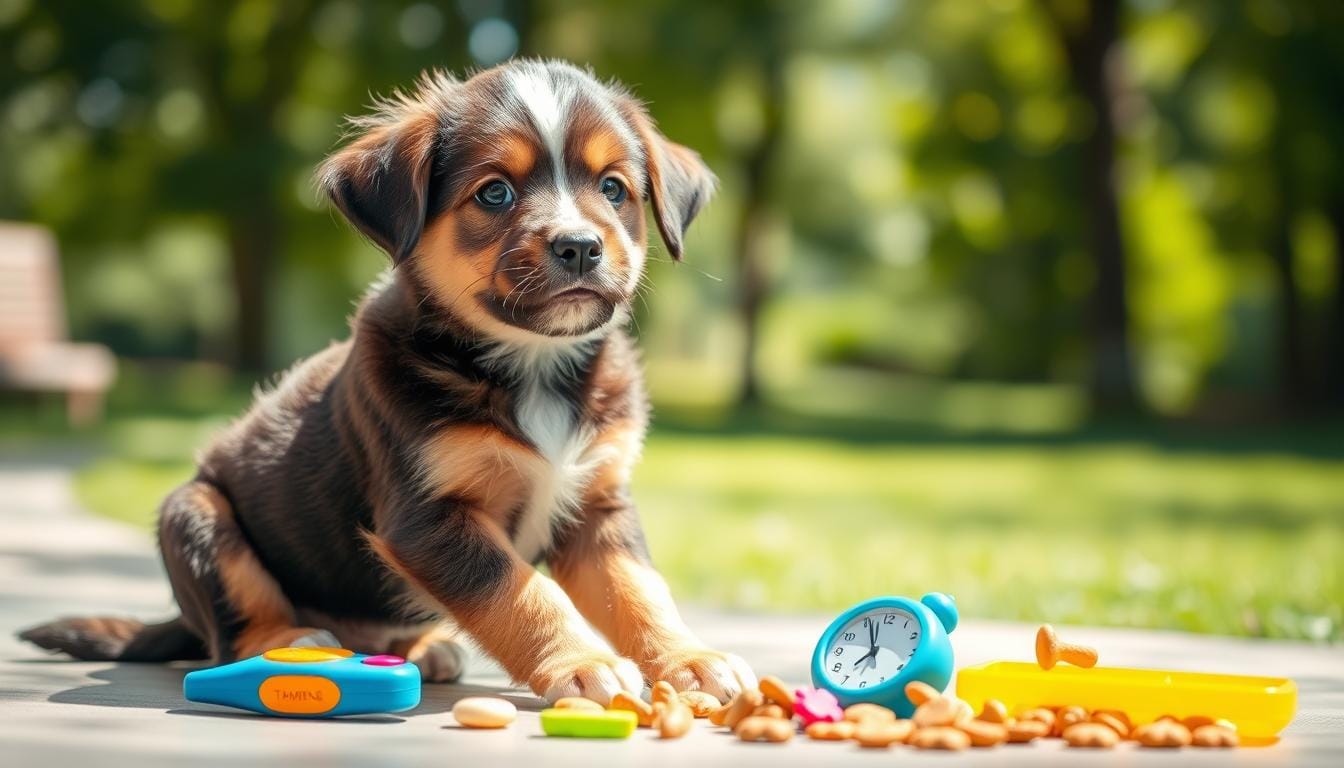
Timing is key when training a new puppy. Teaching basic commands and setting boundaries early helps your puppy succeed. It also prevents bad behaviors that can lead to problems4. Start training early to avoid bad habits and build a strong foundation for your puppy’s growth.
Socialization is a critical part of puppy training. Puppies need to meet new people, dogs, and places by 14-16 weeks4. This helps them feel confident and prevents fear-based behaviors. Here are some tips for socializing your puppy:
- Introduce your puppy to new people, dogs, and environments daily
- Keep training sessions short and fun to maintain your puppy’s attention5
- Use positive reinforcement techniques, such as treats and praise, to encourage good behavior6
By following these tips, you can help your puppy grow into a well-behaved adult dog. Always be patient and consistent. Reward good behavior with positive reinforcement6. With time and effort, your puppy will become a loving member of your family.
Common Mistakes to Avoid When Train New Puppy

Training a new puppy requires avoiding common mistakes. Using inconsistent commands and mixed signals can confuse them. This can lead to bad behaviors. Research shows that 80% of dog owners make repetitive cues, causing confusion7.
It’s also important to practice commands outside of classes. Only 50% of owners do this, which slows learning7. Start training your puppy as soon as you bring them home, ideally at 8 to 10 weeks8.
Timing rewards correctly is another mistake. Training when stressed can reduce learning by 60%7. Stay calm and patient to help your puppy learn well. Avoiding these mistakes helps your puppy develop good habits.
Harsh training can make dogs anxious and fearful, leading to aggression8. Positive reinforcement is better than dominance methods. Anxious dogs are harder to train, but positive methods can help8. Using positive reinforcement and avoiding mistakes sets your puppy up for success.
Creating the Right Training Environment
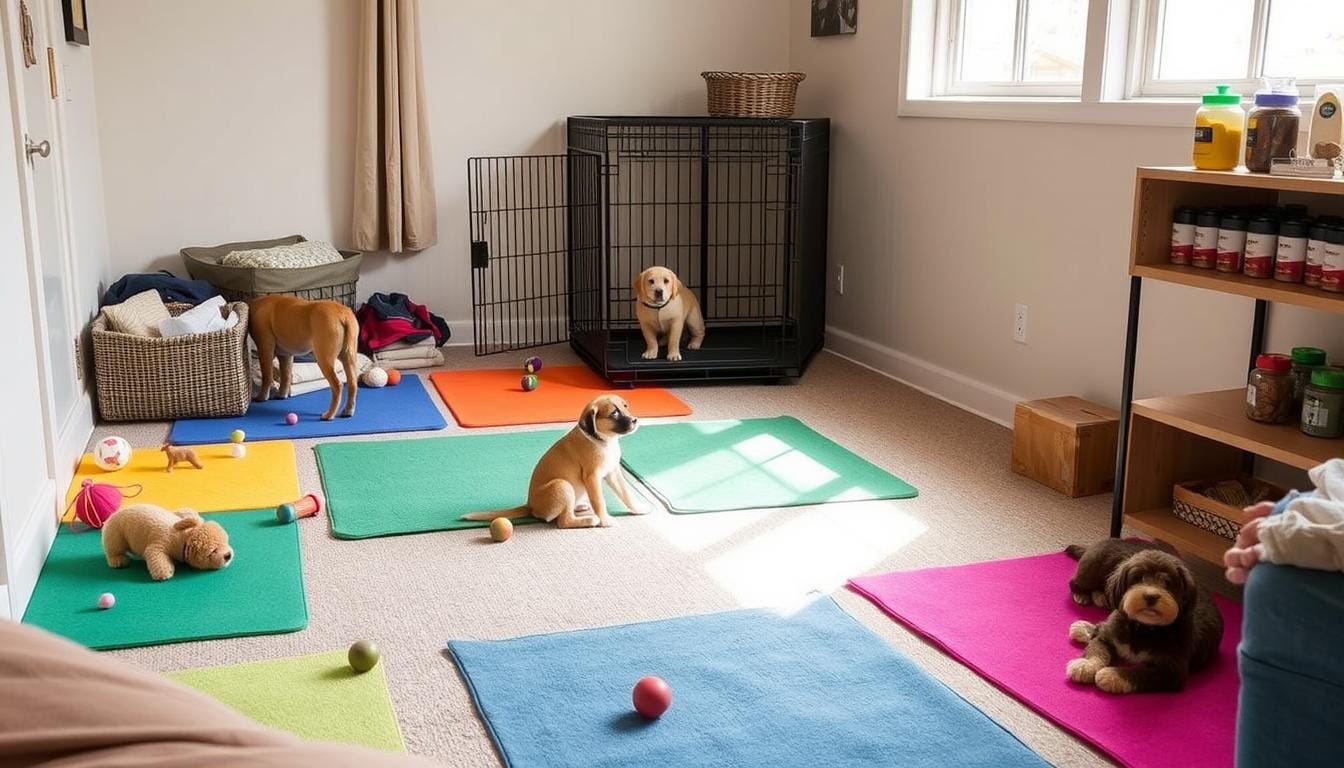
Learning how to train a new puppy right means setting up a safe and structured space. This space should have clear rules and rewards for good behavior9. A well-organized area helps your puppy stay focused and learn better. For example, training in a quiet room is better than a busy park because it has fewer distractions10.
To avoid mistakes, use positive methods like treats and praise, not punishment10. Being consistent with commands helps your puppy understand what you want10. Giving rewards during training makes it more effective, which is important at the start10.
Some important things to think about for a good training space include:
- Providing a quiet and distraction-free space for training
- Using positive reinforcement and rewards for good behavior
- Setting clear boundaries and consequences
- Being consistent in your training approach11
By following these tips and avoiding common mistakes, you can make a great training environment. This will help your puppy learn and grow, preparing them for success9.
| Training Environment | Key Considerations |
|---|---|
| Quiet and distraction-free space | Minimizes distractions, helps puppy focus |
| Positive reinforcement and rewards | Encourages good behavior, makes training enjoyable |
| Clear boundaries and consequences | Helps puppy understand what is expected, reduces confusion |
Positive Reinforcement Techniques and Their Proper Application

Training a new puppy requires positive reinforcement to avoid common mistakes. This method strengthens behavior and builds trust between pet parents and their pets. It’s key for their overall well-being12. Instead of punishing bad behavior, positive reinforcement encourages good actions. This helps prevent fear and aggression12.
To use positive reinforcement well, pick the right treats and use verbal praise. Treats should make up no more than 10% of a puppy’s daily calories to avoid obesity13. Consistent rewards and praise can boost response rates by 40% and successful command responses by 60%13.
Here are some key tips for positive reinforcement training:
- Use immediate rewards and praise to encourage good behavior
- Choose the right treats and keep them small and healthy
- Be consistent in your commands and rewards
- Keep training sessions short and enjoyable
By following these tips, you can help your puppy develop good habits and a strong bond with you. Always track changes in behavior and adjust your training as needed for the best results12.
| Age Range | Training Focus |
|---|---|
| 8-12 weeks | Basic commands and socialization |
| 12-16 weeks | Leash training and housebreaking |
| 4-6 months | Crate training and continued socialization |
With patience, consistency, and positive reinforcement, your puppy can become a well-behaved and loyal companion. Avoiding common puppy training mistakes is crucial13.
House Training Fundamentals and Pitfalls
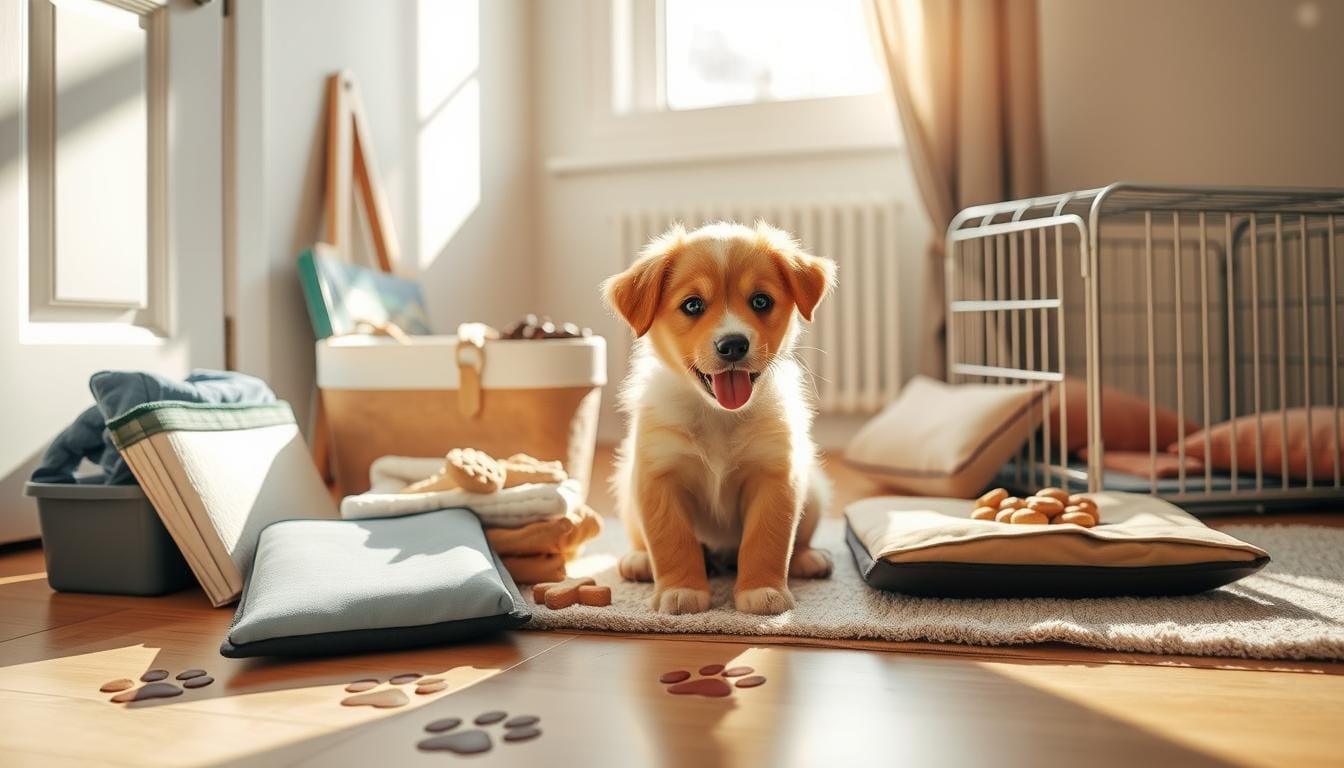
Training a new puppy is all about house training. It needs a routine and positive feedback. Research shows house soiling is a big reason dogs end up in shelters14. So, starting right is key.
Knowing your puppy’s limits is crucial. Puppies can hold their bladders for hours based on their age. For example, a 6-month-old can hold it for about 6 hours14. Puppies can hold it for one hour for each month of age, give or take an hour15.
Take your puppy out often, even when they’re young. You might need to take them out a dozen times in 24 hours14. Feed them small meals three times a day to help with training14. Following these tips can help your puppy learn to go outside and avoid mistakes.
House training takes patience, consistency, and positive feedback. By avoiding common mistakes and following guidelines, you can train your puppy well. With time and effort, you can overcome challenges and achieve successful house training. This will strengthen your bond with your puppy15.
Socialization Errors That Can Affect Your Puppy’s Development
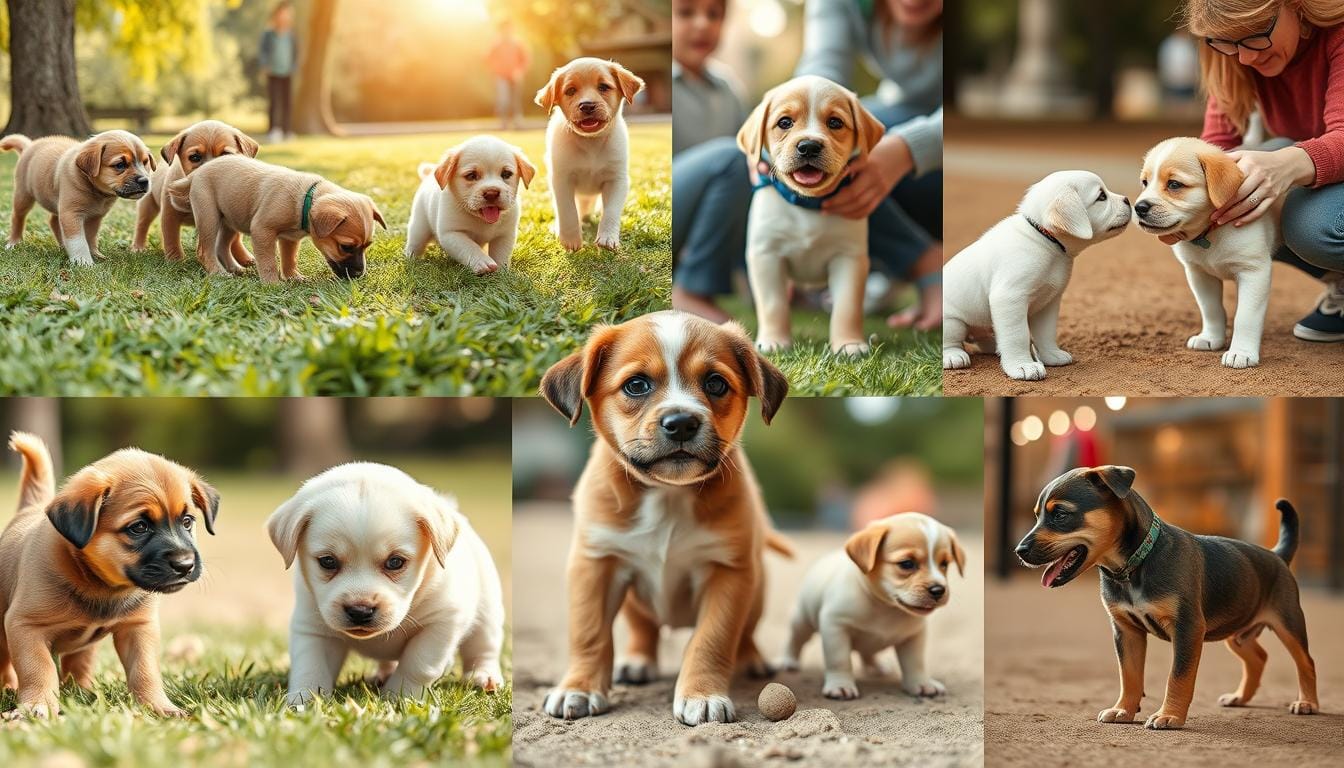
Socialization is key in new puppy training tips. You want your puppy to be confident and well-adjusted in new places. But, missing important times, exposing them too much, or not managing new experiences can lead to problems. Puppies should start socializing early, before their 12-week booster shot, to grow well16.
Introduce your puppy to people, places, and experiences in a positive way. This includes one-on-one playdates and gradually introducing them to more dogs. Keep first meetings with other dogs calm and controlled. By doing this, you help your puppy develop good social skills and avoid common mistakes.
Some important things to remember when socializing your puppy include:
- Start socialization early, ideally before 12 weeks16
- Avoid dog parks until your puppy is fully vaccinated16
- Introduce your puppy to new experiences in a controlled and positive manner17
By following these tips and being careful of socialization errors, you can help your puppy grow into a confident and well-adjusted adult dog.
Behavioral Problems and Their Root Causes
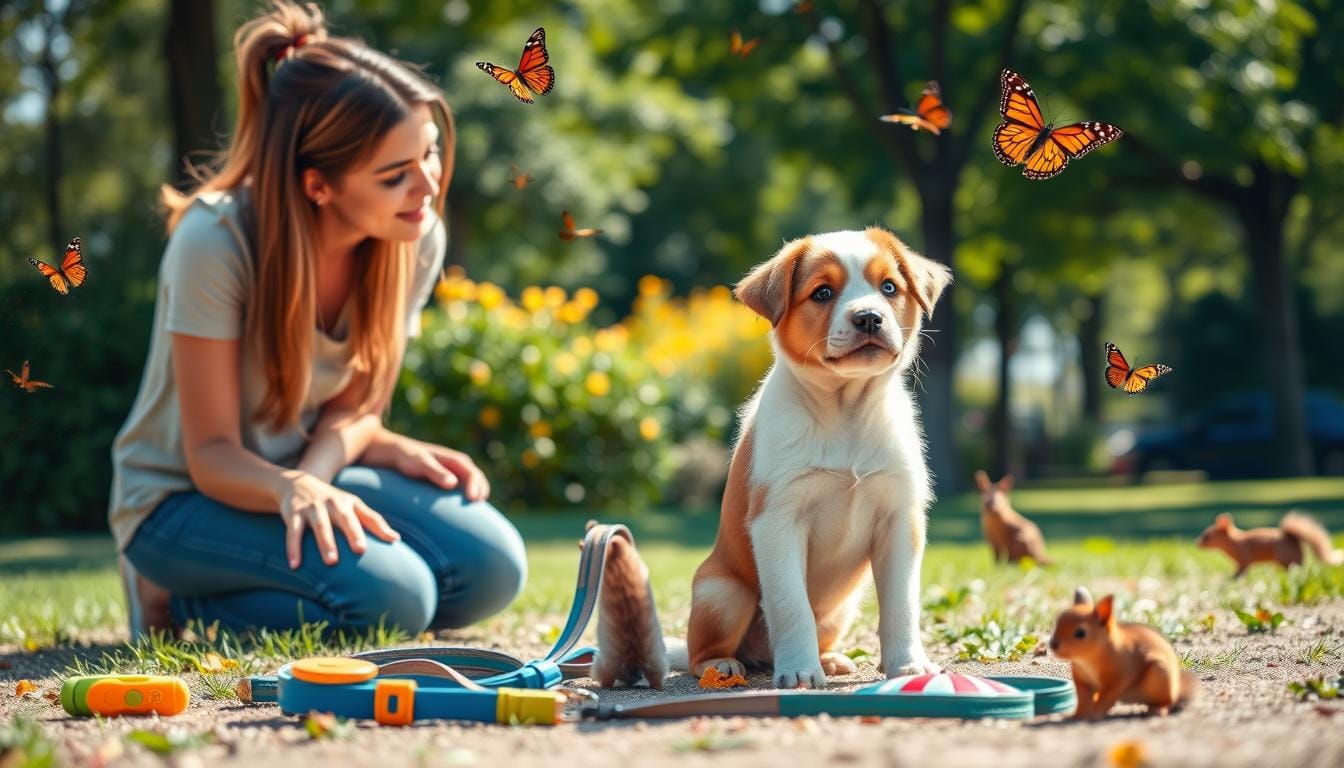
Training a new puppy requires knowing common mistakes that lead to behavioral issues. Mistakes like using commands inconsistently and mixed signals from family can confuse your puppy18. It’s key to have a daily routine that meets your puppy’s needs and offers consistent training and supervision.
Behavioral problems like jumping, chewing, and barking can be fixed with consistent training and positive reinforcement19. About 70% of dog owners face behavioral issues with their dogs, showing the need for early training and intervention19. By understanding your puppy’s behavior and using effective strategies, you can prevent these issues and raise a well-behaved dog.
To tackle behavioral problems, ensure your puppy gets enough exercise, mental stimulation, and supervision. Puppies need more exercise than adult dogs, with at least 30 minutes of vigorous activity daily to reduce bad behaviors19. Regular training, like 10 minutes a day, also improves your puppy’s behavior20. By following these tips and avoiding common training mistakes, you can help your puppy develop good habits.
Here are some additional tips to help you address behavioral problems in your puppy:
- Establish a daily routine that addresses your puppy’s needs
- Provide consistent training and supervision
- Use positive reinforcement techniques, such as treats and praise
- Avoid harsh physical reprimands and punishment-based methods
- Provide adequate exercise, mental stimulation, and supervision
By following these tips and being aware of common puppy training pitfalls, you can help your puppy develop good behaviors and avoid common mistakes in training a new puppy18.
| Behavioral Problem | Root Cause | Solution |
|---|---|---|
| Jumping | Lack of training and supervision | Consistent training and positive reinforcement |
| Chewing | Boredom and lack of mental stimulation | Provide adequate exercise and mental stimulation |
| Barking | Attention seeking and lack of training | Use positive reinforcement techniques and consistent training |
Exercise and Mental Stimulation Balance
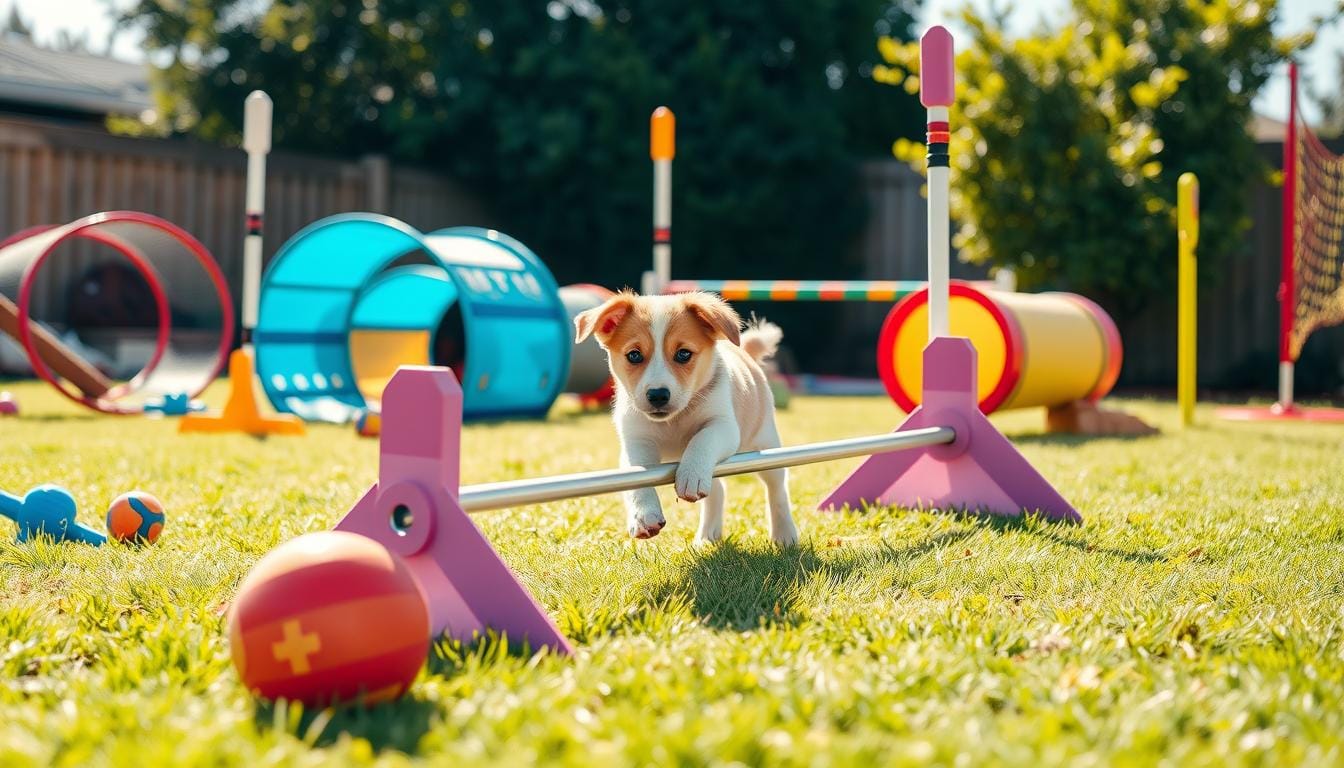
Finding the right balance between exercise and mental stimulation is key when training a new puppy. You want your puppy to be physically active and mentally sharp. Research shows puppies need short play sessions to avoid getting tired, while older dogs prefer gentler play21.
A good exercise plan helps avoid common mistakes like over-exercising. This can cause injuries and behavioral issues. It’s important to match your puppy’s activities to their age, breed, and needs. For instance, active breeds need more energetic play than calm ones21.
Here are some tips for balancing exercise and mental stimulation:
- Provide regular playtime, such as short walks or play sessions in the yard
- Incorporate training into daily activities, such as practicing commands during walks
- Use interactive toys or mental exercises to keep your puppy entertained and stimulated
Success in puppy training comes from balancing physical and mental activities. By offering a variety of activities suited to your puppy’s needs, you can avoid common mistakes. This helps raise a happy, healthy, and well-adjusted dog22.
Building Trust and Establishing Leadership
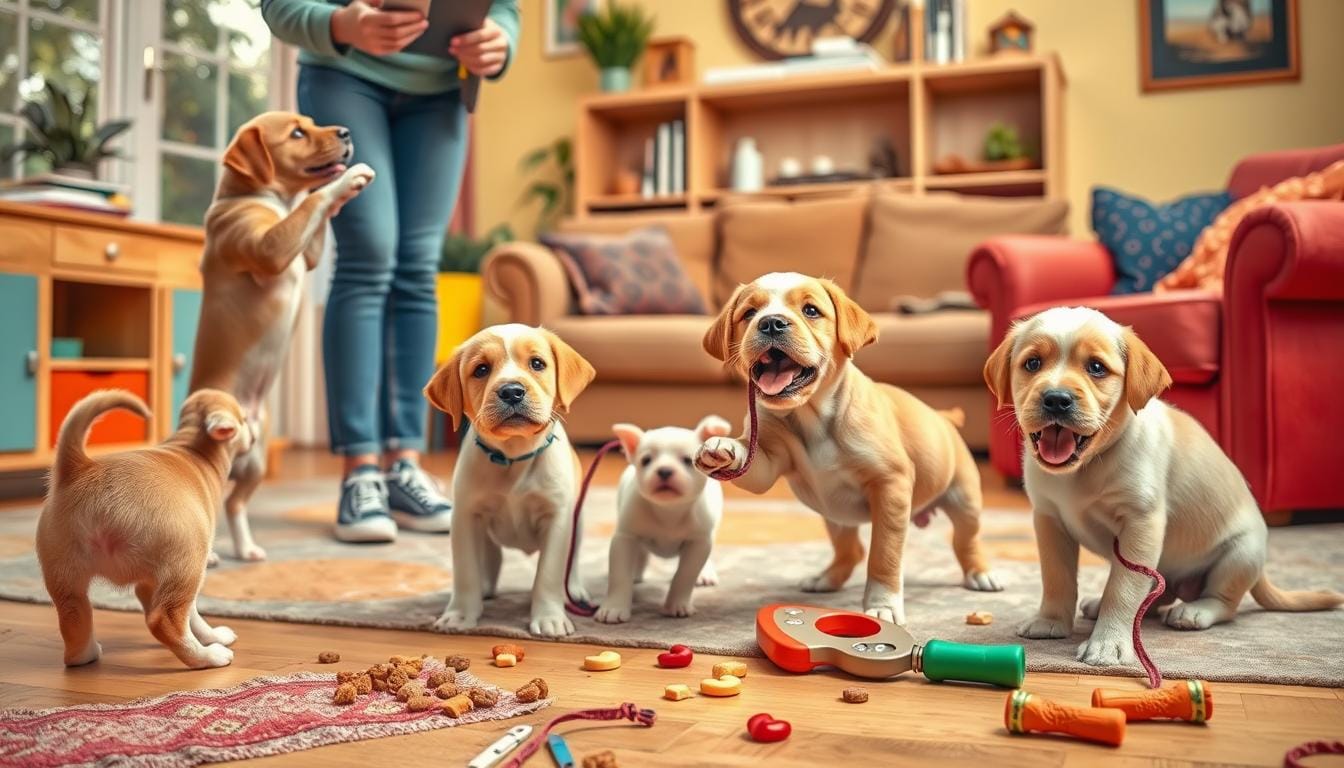
When you train a new puppy, building a strong bond is key. This bond is based on trust and leadership. It’s important for effective training and helps you avoid common mistakes.
Puppies start testing their owners’ leadership around four months old. They may have temper tantrums during this time23.
To lead your puppy, you must communicate well. This means reading their body language and avoiding mistakes. Dogs need confident leadership all their lives to stay well-behaved24.
Understanding your puppy’s body language and sounds helps you connect. Dogs use scent and body language to tell us what they mean24.
Here are some tips for building trust and leadership:
- Be consistent and kind in your interactions
- Have a daily routine for feeding, play, and training
- Avoid mistakes like using commands wrong and timing rewards poorly
By following these tips, you can create a solid base for your puppy’s growth. Building trust and leadership takes time, patience, and positive reinforcement25.
Health Considerations During Training
When training your puppy, it’s key to think about their health. Good food, vet visits, and fun activities are vital for their health and happiness26. Without enough fun, puppies might bark too much, dig, or chew things they shouldn’t. This can make them anxious26.
About 60% of puppies get tired or act out because they’re not getting enough to do26. A set routine helps a lot. It makes dogs feel safe and happy, cutting down anxiety by 20%26. But, be careful not to scare them with harsh training. This can make them more scared and anxious27.
Most dog problems start with not fixing small issues early on27. So, make sure to create a loving space for your puppy to grow.
Some important health tips include:
- Regular vet visits and shots
- Good, healthy food to avoid obesity
- Fun activities and games to keep them busy
By focusing on these health tips, your puppy will grow into a happy, healthy dog. And you’ll avoid common training mistakes26.
Avoid These Puppy Training Mistakes & Raise a Well-Behaved Dog!
Training a puppy is exciting, but common mistakes can lead to frustration and bad habits. Are you unknowingly making these errors?
✅ Using punishment instead of positive reinforcement?
✅ Being inconsistent with commands?
✅ Skipping mental stimulation exercises?
Don’t worry! Brain Training for Dogs by CPDT-KA trainer Adrienne Farricelli teaches proven, force-free methods to correct mistakes and train your puppy effectively.
🚀 Get Lifetime Access for Just $67! 🚀
With step-by-step videos, troubleshooting guides, and expert support, you’ll gain the skills to train your puppy the right way—risk-free with a 60-day money-back guarantee!
👉 Start training smarter today! Click Here to Begin
Conclusion: Setting Your Puppy Up for Success
Starting your puppy’s training journey is exciting. But, it’s crucial to set them up for success. Avoid common mistakes and use positive reinforcement to help your puppy grow into a well-behaved dog28. Being consistent, patient, and understanding will help build a strong bond and ensure your puppy’s happiness29.
The early days of training can be tough. But, with the right approach, you can overcome challenges and help your puppy thrive. Stay dedicated, celebrate small wins, and enjoy the journey of making your puppy a great companion2829.
FAQ
When should I start training my new puppy?
Start training your puppy early. They can learn basic commands and boundaries from day one. Early training prevents bad behaviors and builds a strong foundation.
What are the critical stages of puppy development?
Knowing your puppy’s development stages is key for training. The socialization period, from 12 to 15 weeks, is when they learn most. Adjust your training based on their age and learning abilities.
Why is timing important when training a new puppy?
Timing is crucial in puppy training. Start training early to prevent bad behaviors. Early introduction of basic commands and boundaries sets your puppy up for success.
What are some common mistakes to avoid when training a new puppy?
Be aware of common mistakes in puppy training. Avoid inconsistent commands and mixed signals. Use consistent commands and rewards to help your puppy develop good habits.
How do I create the right training environment for my new puppy?
A proper training environment is essential. Provide a safe, structured space for your puppy to learn. Set clear boundaries and reward good behavior.
What are the best positive reinforcement techniques for puppy training?
Positive reinforcement is key in puppy training. Use rewards and praise for good behavior. Choose the right treats and use verbal praise and physical rewards for timing.
What are the key steps for house training my new puppy?
House training is critical. Establish a consistent routine and reward good behavior. This helps your puppy learn to eliminate outside and avoid accidents.
What are the common socialization errors that can affect my puppy’s development?
Socialization is vital. Avoid missing critical windows and over-exposing your puppy. Introduce them to new experiences in a controlled, positive way to develop good social skills.
How do I address behavioral problems in my new puppy?
Addressing behavioral problems early is crucial. Identify the root causes of your puppy’s behavior. Develop strategies to address these problems and prevent common mistakes.
How do I balance exercise and mental stimulation for my new puppy?
Balance exercise and mental stimulation for your puppy’s development. Tailor activities to their age and developmental stage. Avoid over-exercise to ensure physical and mental growth.
How do I build trust and establish leadership with my new puppy?
Building trust and leadership is essential. Be aware of communication errors that can undermine your relationship. Read puppy body language and avoid common mistakes to build trust and a strong bond.
What health considerations should I keep in mind during puppy training?
Health is critical during training. Monitor your puppy’s physical and mental well-being. Prevent common mistakes that can lead to behavioral problems and ensure a healthy adult dog.
Source Links
- https://www.dogsavvylosangeles.com/blog/puppy-training-mistakes-to-avoid – 5 Biggest Puppy Training Mistakes | Dog Savvy
- https://vcahospitals.com/know-your-pet/puppy-behavior-and-training-training-basics – Puppy Behavior and Training Basics | VCA Canada Animal Hospitals
- https://sitmeanssit.com/dog-training-mu/portland-dog-training/blog/understanding-puppy-development/ – Understanding Puppy Development and Using to Your Advantage
- https://academyfordogtrainers.com/puppy-priorities/ – Puppy Priorities: What Really Matters in the First Few Weeks
- https://kastensdogtraining.com/the-first-30-days-with-your-new-puppy-training-and-bonding/ – The First 30 Days with Your New Puppy: Training and Bonding – Kasten’s Dog Training
- https://www.offleashmke.com/blog/common-mistakes-with-training-treats – Common Mistakes with Training Treats — Off Leash MKE
- https://www.akc.org/expert-advice/training/train-dog-common-mistakes-avoid / – No title found
- https://unleashfido.com/3-mistakes-to-avoid-when-puppy-training-in-tampa/ – 3 Mistakes To Avoid When Puppy Training In Tampa | Unleash Fido
- https://royvon.co.uk/five-mistakes-to-avoid-with-a-new-puppy-puppy-training-royvon/ – Five mistakes to avoid with a new puppy | Puppy Training | Royvon
- https://bestfriends.org/pet-care-resources/dog-training-tips-dos-and-donts – Dog Training Tips: Do’s and Don’ts
- https://www.gundogmag.com/editorial/how-to-avoid-common-puppy-training-problems/460731 – How to Avoid Common Puppy Training Problems – Gun Dog
- https://www.petmd.com/dog/behavior/how-to-train-a-dog-with-positive-reinforcement – How To Train a Dog With Positive Reinforcement
- https://careyanimalhospital.com/blog/blog-puppy-training/ – 7 Tips and Tricks for Training Your Puppy – Carey Animal Hospital
- https://www.akc.org/expert-advice/training/how-to-potty-train-a-puppy/ – No title found
- https://indoorpet.osu.edu/dogs/puppy/housetraining-dogs – Housetraining | Indoor Pet Initiative
- https://www.eukanuba.com/au/puppy/puppy-articles/a-guide-to-socialising-your-new-puppy – A Guide To Socialising Your New Puppy | Eukanuba | Eukanuba
- https://www.woofliketomeet.com/2017/03/problem-behaviours-poor-socialisation/ – Problem Behaviours: Poor Socialisation – Woof Like To Meet
- https://vcahospitals.com/know-your-pet/puppy-behavior-and-training—dealing-with-undesirable-behavior – Puppy Behavior and Training – Dealing with Undesirable Behavior | VCA | VCA Animal Hospitals
- https://www.akc.org/expert-advice/training/how-to-curb-unwanted-dog-behaviors/ – No title found
- https://www.oneminddogs.com/blog/dont-get-caught-in-the-puppy-bubble-trap-the-number-1-puppy-training-mistake-to-avoid/ – Don’t get caught in the “Puppy Bubble” trap! The number 1 puppy training mistake to avoid – OneMind Dogs
- https://thenaturaldogstore.com/blogs/health/training-through-play – Training Through Play (How To Play With Dog For Training)
- https://www.keendogtraining.com/blog/avoid-these-5-common-mistakes-a-guide-for-new-dog-owners – Avoid These 5 Common Mistakes: A Guide for New Dog Owners
- https://www.akc.org/expert-advice/training/how-to-establish-a-routine-and-boundaries-with-your-puppy/ – No title found
- https://animalcarecentersmyrna.com/how-to-be-a-confident-leader-for-a-new-rescue-dog/ – How to Be a Confident Leader for a New Rescue Dog – Animal Care Center
- https://doggear.com.au/blogs/dog-training-australia/building-a-strong-bond-with-your-dog-how-training-enhances-the-human-canine-relationship – Building a Strong Bond with Your Dog: How Training Enhances the Human-Canine Relationship
- https://unleashfido.com/common-dog-training-mistakes-to-avoid/ – 10 Common Dog Training Mistakes To Avoid | Unleash Fido
- https://kastensdogtraining.com/common-mistakes-to-avoid-when-training-your-dog/ – Common Mistakes to Avoid When Training Your Dog
- https://caninecohen.com/newdog – You Just Adopted A Dog, Now What? — Canine Cohen Dog Training — Canine Cohen Dog Training
- https://vcahospitals.com/know-your-pet/crate-training-your-dog—an-overview – Life Skills for Pets: Crate Training and Confinement for Puppies and Dogs | VCA Animal Hospitals

